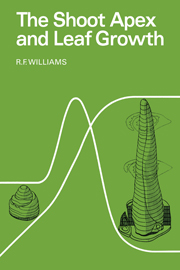5 - The dynamics of leaf growth
Published online by Cambridge University Press: 04 August 2010
Summary
Much has already been said about leaf growth, because this is essential to the definition of the patterns of growth within shoot-apical systems. For two of those systems, however, Williams and Rijven (1965, 1970) have provided descriptions of growth and chemical change which relate to leaf growth as such.
Leaves are organs of limited growth arising laterally on the shoot apex, and they exhibit a steady progression from the meristematic condition of the primordium through to maturity and senescence. It is scarcely surprising, therefore, to find strong similarities in this progression even for such different plants as subterranean clover and wheat. Both studies happen to be on the fourth leaf of the primary shoot, and they are concerned mainly with changes in DNA, RNA, proteins and cell wall materials. The plants were grown in controlled environments, and the work achieved a high level of precision through sampling methods and chemical procedures which are fully described in the original papers. This chapter summarizes the main results.
SUBTERRANEAN CLOVER
The fourth leaf of subterranean clover was chosen because it is the first on the main axis to attain the characteristic form and size of the adult trifoliate leaf, and because its development could scarcely have been influenced by cotyledonary reserves. Fig. 5.1 illustrates the changing size and form of the fourth leaf from day 7, the earliest stage for which cell counts are available. The first chemical data relate to day 10, when the primordia are still only 0.66 mm long. The drawings of Fig. 5.1 include a thin disc of stem tissue, the disc of leaf attachment, but this was not in the samples.
- Type
- Chapter
- Information
- Shoot Apex and Leaf Growth , pp. 163 - 182Publisher: Cambridge University PressPrint publication year: 1975

